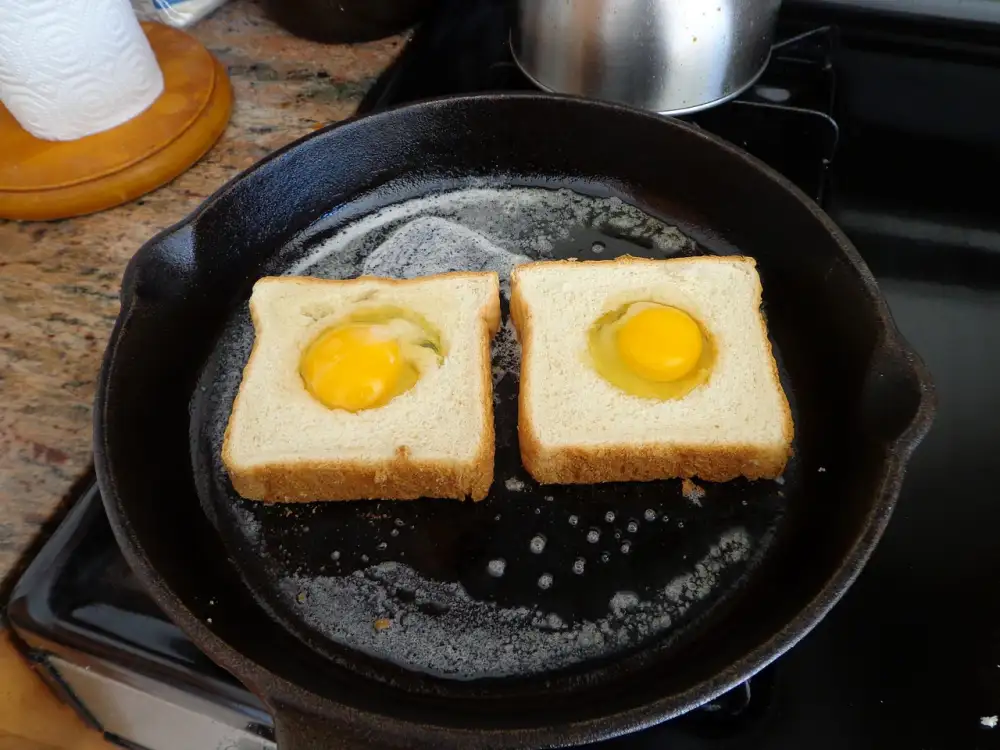Ultimate Guide: How to Clean a Cast Iron Skillet Like a Pro

- Gather necessary supplies: coarse salt, paper towels, hot water, mild dish soap, scrub brush, and a clean towel.
- Allow the skillet to cool down before cleaning to avoid burns.
- Sprinkle a generous amount of coarse salt on the skillet's surface.
- Use a paper towel to scrub the salt in a circular motion to remove food residue.
- Rinse the skillet under hot water and avoid using soap at this stage.
- For stubborn residue, add a small amount of mild dish soap and scrub with a brush.
- Rinse thoroughly and dry the skillet with a clean towel.
- To prevent rust, place the skillet on the stove over low heat until completely dry.
- Apply a thin layer of oil to the skillet's surface to maintain its seasoning.
Gather necessary supplies: coarse salt, paper towels, hot water, mild dish soap, scrub brush, and a clean towel.
Before you begin cleaning your cast iron skillet, make sure you have all the necessary supplies on hand. You will need coarse salt to help scrub off any food residue, paper towels for wiping, hot water for rinsing, mild dish soap for tougher stains, a scrub brush for deep cleaning, and a clean towel for drying. Having these items ready will ensure a smooth and effective cleaning process for your cast iron skillet.
Allow the skillet to cool down before cleaning to avoid burns.
Before diving into the cleaning process, it's crucial to allow the cast iron skillet to cool down completely. Cast iron retains heat very well, and attempting to clean it while still hot can result in burns or injuries. To avoid any accidents, let the skillet sit on a heat-resistant surface until it reaches a safe temperature for handling. This simple step ensures a safe and effective cleaning experience for your cast iron skillet.
Sprinkle a generous amount of coarse salt on the skillet's surface.
After allowing the cast iron skillet to cool down, the next step in cleaning it like a pro is to sprinkle a generous amount of coarse salt on its surface. The coarse salt acts as an abrasive agent that helps to lift off any stuck-on food particles without damaging the skillet's seasoning. This method is effective in removing residue while being gentle on the cast iron surface. The salt also helps to absorb any excess oil or grease, leaving the skillet clean and ready for the next use.
Use a paper towel to scrub the salt in a circular motion to remove food residue.
After sprinkling a generous amount of coarse salt on the surface of your cast iron skillet, it's time to start scrubbing. Take a paper towel and begin to scrub the salt in a circular motion. The abrasiveness of the salt will help to loosen any stuck-on food residue without damaging the seasoning of the skillet. Make sure to apply gentle pressure while scrubbing to effectively remove any remaining bits of food. This step is crucial in ensuring that your cast iron skillet remains clean and well-maintained for future use.
Rinse the skillet under hot water and avoid using soap at this stage.
After scrubbing the skillet with coarse salt to remove food residue, it's time to rinse it under hot water. The hot water helps to loosen any remaining bits of food without the need for soap, which can strip away the skillet's seasoning. Avoid using soap at this stage as it can interfere with the natural non-stick surface that develops on a well-seasoned cast iron skillet. Simply use hot water and a scrub brush to clean off any remaining salt and food particles before moving on to the next step in the cleaning process.
For stubborn residue, add a small amount of mild dish soap and scrub with a brush.
For stubborn residue, add a small amount of mild dish soap to the skillet. Use a scrub brush to gently scrub the surface, focusing on areas with stuck-on food particles. The gentle abrasiveness of the brush combined with the soap will help break down and lift off any tough residue. Be sure to rinse the skillet thoroughly after scrubbing to remove all traces of soap before drying it with a clean towel.
Rinse thoroughly and dry the skillet with a clean towel.
After scrubbing the skillet with salt and, if necessary, mild dish soap, it's time to rinse thoroughly. Make sure to remove all traces of soap to prevent any unwanted flavors in your next meal. Rinse the skillet under hot water, using a scrub brush if needed to dislodge any remaining food particles. Once clean, dry the skillet completely with a clean towel to prevent any water spots or potential rusting. This step is crucial in maintaining the integrity of your cast iron skillet for years to come.
To prevent rust, place the skillet on the stove over low heat until completely dry.
To prevent rust, place the skillet on the stove over low heat until completely dry. This step is crucial as any moisture left on the cast iron skillet can lead to rust formation. By heating the skillet gently on the stove, you ensure that all water evaporates, leaving the surface dry and ready for storage. Remember to handle the hot skillet with care using oven mitts or a thick towel to avoid burns. Once dried, store your cast iron skillet in a cool, dry place to maintain its quality and prevent rusting.
Apply a thin layer of oil to the skillet's surface to maintain its seasoning.
After cleaning and drying your cast iron skillet, it's crucial to maintain its seasoning by applying a thin layer of oil. This step helps prevent rust and keeps the skillet in top condition for cooking. You can use any high smoke-point oil such as vegetable oil, flaxseed oil, or canola oil. Simply pour a small amount of oil onto a paper towel and rub it all over the skillet's surface, including the handle and outer edges. Make sure to coat the entire skillet evenly to create a protective barrier against moisture and food particles. This simple maintenance routine will help prolong the life of your cast iron skillet and enhance its non-stick properties with each use.
Published: 02. 04. 2024
Category: Home



